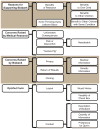Parental Perspectives on a Pediatric Human Non-Subjects Biobank
- PMID: 23181193
- PMCID: PMC3501745
- DOI: 10.1080/21507716.2012.662576
Parental Perspectives on a Pediatric Human Non-Subjects Biobank
Abstract
BACKGROUND: Genomic biorepositories will be important tools to help unravel the effect of common genetic variants on risk for common pediatric diseases. Our objective was to explore how parents would respond to the inclusion of children in an opt-out model biobank. METHODS: We conducted semi-structured interviews with parents in hospital-based pediatric clinics. Participants responded to a description of a biorepository already collecting samples from adults. Two coders independently analyzed and coded interviews using framework analysis. Opt-out forms were later piloted in a clinic area. Parental opt-out choices were recorded electronically, with opt-out rates reported here. RESULTS: Parents strongly supported medical research in general and expressed a high level of trust that Vanderbilt University would keep their child's medical information private. Parents were more likely to allow their child's sample to be included in the biorepository than to allow their child to participate in a hypothetical study that would not help or harm their child, but might help other children. Only a minority were able to volunteer a concern raised by the description of the biobank. The opt-out rate was initially high compared with the opt-out rate in the adult biorepository, but after the first week decreased to near the baseline in adult clinics. CONCLUSION: Parents in our study generally support an opt-out model biobank in children. Most would allow their own child's sample to be included. Institutions seeking to build pediatric biobanks may consider the human non-subjects model as a viable alternative to traditional human-subjects biobanks.
Figures
References
-
- Brothers KB, Clayton EW. ‘Human Non-Subjects Research’: Privacy and Compliance. American Journal of Bioethics. 2010;10(9):15–17. - PubMed
-
- Gurwitz D, Fortier I, Lunshof JE, Knoppers BM. Children and population biobanks. Science. 2009;325(5942):818. - PubMed
-
- Hens K, Nys H, Cassiman JJ, Dierickx K. Risks, Benefits, Solidarity: A Framework for the Participation of Children in Genetic Biobank Research. The Journal of Pediatrics. 2011;158(5):842–848. - PubMed
Grants and funding
LinkOut - more resources
Full Text Sources




